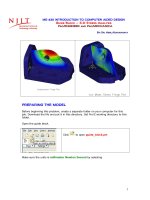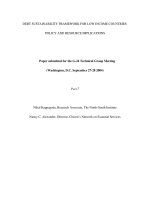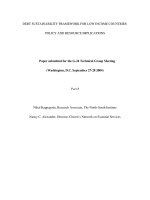- Trang chủ >>
- Khoa Học Tự Nhiên >>
- Vật lý
Tài liệu Open channel hydraulics for engineers. Chapter 6 transitions and energy dissipators docx
Bạn đang xem bản rút gọn của tài liệu. Xem và tải ngay bản đầy đủ của tài liệu tại đây (342.19 KB, 23 trang )
OPEN CHANNEL HYDRAULICS FOR ENGINEERS
-----------------------------------------------------------------------------------------------------------------------------------
-----------------------------------------------------------------------------------------------------------------------------------
Chapter 6: TRANSITIONS AND ENERGY DISSIPATORS
107
Chapter
TRANSITIONS AND
ENERGY DISSIPATORS
_________________________________________________________________________
6.1. Introduction
6.2. Expansions and Contractions
6.3. Drop structures
6.4. Stilling basins
6.5. Other types of energy dissipators
_________________________________________________________________________
Summary
The term "transition" is introduced whenever a channel's cross-sectional configuration
(shape and dimension) changes along its length. Beside it, in the water control design,
engineers need to provide for the dissipation of excess kinetic energy possessed by the
downstream flow. Formulas for design calculation of transition works and energy
dissipators are presented in this chapter.
Key words
Transition; expansion; contraction; energy dissipator; drop structure; stilling basin
_________________________________________________________________________
6.1. INTRODUCTION
A transition may be defined as a change either in the direction, the slope, or the
cross section of the channel that produces a change in the state of the flow. Most
transitions produce a permanent change in the flow, but some (e.g. channel bends) produce
only transient changes, the flow eventually returning to its original state. Practically all
transitions of engineering interest are comparatively short features, although they may
effect the flow for a great distance upstream or downstream.
In the treatment of transitions, as of every other topic in open channel flow, the distinction
between subcritical and supercritical flow is of prime importance. It will be seen that
design and performance of many transitions are critically dependent on which one of these
two flow regimes is operative.
In the design of a control structure there is often a need to provide for the dissipation of
excess kinetic energy possessed by the downstream flow. The result is that devices known
as energy dissipators are a common feature of control structures. The need for them may
arise from the occasional discharge of flood waters, as in the spillway of a dam, or from
some other factor.
In general two methods are in common use to dissipate the energy of the flow. First, there
are abrupt transitions or other features, which induce severe turbulence: in this class we
can include sudden changes in direction (such as result from the impact at the base of a
free overfall) and sudden expansions (such as in the hydraulic jump). In the second class
methods are based on throwing the water a long distance as a free jet, in which form it will
readily break up into small drops, which are very substantially retarded before they reach
any vulnerable surface.
OPEN CHANNEL HYDRAULICS FOR ENGINEERS
-----------------------------------------------------------------------------------------------------------------------------------
-----------------------------------------------------------------------------------------------------------------------------------
Chapter 6: TRANSITIONS AND ENERGY DISSIPATORS
108
6.2. EXPANSIONS AND CONTRACTIONS
6.2.1. The transition problem
We know that the equation of the total energy-head H in an open channel may be
written as:
g2
Vg
zH
2
(6-1)
where z is defined as the height of the bed above datum, h is the vertical distance from the
bed to the water surface (in case of parallel stream lines). Above equation is to be used in
practice. The problem is essentially similar to the elementary one of calculating the
discharge in a pipe from the upstream and throat pressure in a Venturi meter. However, in
those problems where the depth at some section is not specified in advance, but is to be
calculated from our knowledge of some change in the channel cross-section, we encounter
the feature of open channel flow that lends it its special difficulty and interest. It is the fact
that the depth h plays a dual role: it influences the energy equation, and also the continuity
equation, since it helps to determine the cross-sectional area of flow. The problems
involved are the best appreciated by considering the two situations shown in Fig. 6.1, each
of them amounting to a simple constriction in the flow passage, smooth enough to make
energy losses negligible. Suppose that in each case the problem is to determine conditions
within the constriction, if the upstream conditions are given.
Fig. 6.1. The transition problem
In the pipe-flow case we can, from the known reduction in area, readily calculate the
increase in velocity and in velocity head, and hence the reduction in pressure. The open-
channel-flow case, however, is not quite so straightforward. We have a smooth upward
step in the otherwise horizontal floor of a channel having a rectangular cross-section.
6.2.2.
Expansions and Contractions
These features are often required in artificial channels for a variety of practical
purposes. As we shall see, supercritical flow in particular brings about certain complex
flow phenomena, which make the simplified viewpoints of Chapter 1 and Chapter 2 quite
inadequate.
As implied by this last remark, the behaviour of expansions and contractions depends on
whether the flow is subcritical or supercritical. The following treatment is subdivided
accordingly.
flow
(a) Pipe flow
flow
h
1
h
2
?
z
2
1
V
2g
2
2
V
?
2g
(b) Open channel flow
OPEN CHANNEL HYDRAULICS FOR ENGINEERS
-----------------------------------------------------------------------------------------------------------------------------------
-----------------------------------------------------------------------------------------------------------------------------------
Chapter 6: TRANSITIONS AND ENERGY DISSIPATORS
109
Subcritical flow
If for the time being we postpone consideration of wave formation at changes of channel
section, this type of flow raises no problems, which are not already implicit in the theory of
Chapters 2, 3 and 4. The problem, which still requires explicit consideration, is that of
energy loss when the expansion or contraction is abrupt, and we should expect this
problem to be tractable by methods similar to those used in the study of pipe flow. For
example, consider the abrupt expansion in width of a rectangular channel shown in plan
view in Fig. 6.2. By analogy with the pipe-flow case we would treat this case by setting E
1
= E
2
and F
2
= F
3
, assuming (a) that the depth across section 2 is constant and equal to the
depth at section 1; (b) that the width of the jet of moving water at section 2 is equal to b
1
.
Fig. 6.2. Plan view of abrupt channel expansion
Manipulation of the resulting equations is much more awkward than in the pipe-flow case,
but if it is assumed that Fr
1
is small enough for Fr
1
2
and higher powers to be neglected,
according to Henderson (1966), the energy loss between sections 1 and 3 is equal to:
2
2 3
2
1 1 2 1
1 1
1 3
4
2 2
2Fr b b b
V b
E E E 1
2g b b
(6-2)
The last term inside the brackets is the open-channel-flow term, which vanishes, as Fr
1
tends to zero. In this case h
1
= h
2
= h
3
, and the situation is equivalent to closed-conduit
flow, i.e.
2
1 3
V V
E
2g
(6-3)
The term containing Fr
1
2
in Eq. (6-2) does not contribute a great deal to the total energy-
head loss unless Fr
1
> 0.5, or b
2
/b
1
< 1.5. The former condition is not often fulfilled, and
the latter would, if true, make the total head loss very small, in which case little interest
would attach to the relative size of its components. Eq. (6-3) can therefore be
recommended as safe for most normal circumstances; in fact the experiments of Formica
(1955) have indicated an energy-head loss of sudden expansions some 10 percent less than
the value given by this equation.
Just as in the pipe-flow case, the energy-head loss is reduced by tapering the side walls;
when the taper of the line joining tangent points is 1:4, as in the broken lines in Fig. 6.3.a,
the head loss is only about one-third of the value given in Eq. (6-2); it is given by some
authorities as:
3
2 1
b
1
b
2
flow
OPEN CHANNEL HYDRAULICS FOR ENGINEERS
-----------------------------------------------------------------------------------------------------------------------------------
-----------------------------------------------------------------------------------------------------------------------------------
Chapter 6: TRANSITIONS AND ENERGY DISSIPATORS
110
2
1 3
V V
E 0.3
2g
(6-4)
and by other as
22
31
VV
E 0.1
2g 2g
(6-5)
The former of these is to be preferred, but over the range 1.5 < V
1
/V
3
< 2.5 the two
equations do not give greatly different results. In any event, a more gradual taper does not
usually make savings in energy head commensurate with the extra expense, so the amount
of 1:4 is the one normally recommended for channel contractions in subcritical flow. Given
that this angle of divergence is to be used, the exact form of the sidewalls is not a matter of
great importance, provided that they follow reasonably smooth curves without sharp
corners, as in the two cases shown in Fig. 6.3. In the first of these, both upstream and
downstream sections are rectangular and the sidewalls are generated by vertical lines; in
the second case a warped transition is required to transfer from a trapezoidal to a
rectangular channel.
Fig. 6.3. Channel expansions for subcritical flow
Head losses through contractions are smaller than through expansions, just as in the case of
pipe flow. An equation could be derived analogous to Eq. (6-2) with section 2 taken at the
vena contracta just downstream of the entrance to the narrower channel, and section 3
where the flow has become uniform again downstream. However, direct experimental
measurements provide a better approach, for experiment would be needed in any case to
determine the contraction coefficient. The results of Formica (1955) indicate energy-head
losses up to 0.23 V
3
2
/2g for square-edged contractions in rectangular channels and up to
0.11 V
3
2
/2g when the edge is rounded – e.g. in the cylinder-quadrant type shown in Fig.
6.4. The results of Yarnell (1934) obtained in connection with an investigation into bridge
piers indicated larger coefficients – up to 0.35 and 0.18 for square and rounded edges,
respectively. Formica’s results showed that the coefficients increased with the ratio h
3
/b
2
,
reaching the above maximum values when this ratio reached a value of about 1.3. When
h
3
/b
2
1, these coefficients reduced to about 0.1 and 0.04. Yarnell did not report values of
depth : width ratio.
(a) Plan view of rectangular channel
1
4
flow
flow
1
4
channel
central
line
(b) Warped transition from trapezoidal to rectangular section
OPEN CHANNEL HYDRAULICS FOR ENGINEERS
-----------------------------------------------------------------------------------------------------------------------------------
-----------------------------------------------------------------------------------------------------------------------------------
Chapter 6: TRANSITIONS AND ENERGY DISSIPATORS
111
Fig. 6.4. Cylinder-quadrant contraction for subctitical flow
Supercritical flow
In the preceding discussion on subcritical flow it was assumed that the velocity and the
depth remained the same across every section. This assumption is approximately correct,
notwithstanding the fact, that within a contraction the velocity may be higher near the
sidewalls than it is in midstream. However, when the flow is supercritical there is a further
complication in the form of wave motion. This is not confined to supercritical flow, but
assumes particular importance when the flow is in that condition. What happens is that any
obstacle in the path of the flow generates a surface wave, which moves across the flow and
is at the same time carried downstream; the end result is an oblique standing wave,
precisely analogous to the Mach waves characteristic of supersonic flow.
Fig. 6.5. Movement of a small disturbance at a speed
(a) less than (b) equal to (c) greater than the natural wave velocity
flow
channel
central
line
A
2
A
1
A
2
A
1
direction of movement
of disturbance
shock front
successive wave fronts
(a)
(b)
A
2
A
1
P
2
P
1
A
n
shock front
(c)
OPEN CHANNEL HYDRAULICS FOR ENGINEERS
-----------------------------------------------------------------------------------------------------------------------------------
-----------------------------------------------------------------------------------------------------------------------------------
Chapter 6: TRANSITIONS AND ENERGY DISSIPATORS
112
The formation of such waves is illustrated in Fig. 6.5. Consider a mass of stationary fluid,
with a solid particle moving through it at a speed V comparable with the natural wave
speed c, i.e. the speed with which a disturbance propagates itself through the fluid. When
the particle is at A
1
, it initiates a disturbance which travels outwards at the same velocity in
all directions – i.e. at any subsequent instant there is a circular wave front centered at A
1
.
Similar wave fronts are initiated when the particle passes through points A
2
, A
3
, etc. When
V < c, as in Fig. 6.5a, the particle lags behind the wave fronts; when V = c, as in Fig. 6.5b,
the particle moves at the same speed as, and in the same position as, a shock front formed
from the accumulated wave fronts generated during the previous motion of the partcle. But
when V > c, as in Fig. 6.5c, the particle outstrips the wave fronts. When it reaches A
n
the
wave fronts have reached positions such that they can all be enveloped by a common
tangent A
n
P
1
, which will itself form a distinct wave front. Since a disturbance travels from
A
1
to P
1
in the same time as the particle travels from A
1
to A
n
, it follows that:
1 1
1 n
A P c 1
sin
A A V Fr
(6-6)
Fig. 6.6. Plan view of inclined shock front in supercritical flow
A convenient example of a large disturbance is the deflection of a vertical channel wall
through a finite angle , as in Fig. 6.6. The oblique wave front then formed will bring
about a finite change in depth h, and it is unlikely that the total deflection angle
1
will be
given by Eq. (6-6). However we can readily analyze the situation by treating the wave
front as a hydraulic jump on which a certain velocity component has been superimposed
parallel to the front of the jump; clearly this component must be the same on both sides of
the front, for the change in depth h does not bring about any force directed along the font
of the jump. We can therefore write, using the terms defined in Fig. 6.6,
1 1 2 1
V cos V cos
(6-7)
Considering now the velocity components normal to the wave front, the continuity
equation becomes:
1 1 1 2 2 1
V h sin V h sin
(6-8)
and the momentum equation must clearly lead to the result:
2 2
1 1 2 2
1 1 1
V sin 1 h h
1
gh 2 h h
(6-9)
1
V
1
V
2
shock front
OPEN CHANNEL HYDRAULICS FOR ENGINEERS
-----------------------------------------------------------------------------------------------------------------------------------
-----------------------------------------------------------------------------------------------------------------------------------
Chapter 6: TRANSITIONS AND ENERGY DISSIPATORS
113
which differs from the ordinary hydraulic jump equation (see Eq. (3-15)), only in that V
1
is
replaced by V
1
sin
1
. It follows that;
2 2
1
1 1 1
1 1 h h
sin 1
Fr 2 h h
(6-10)
which reduces to Eq. (6-6) when the disturbance is small and h
2
/h
1
tends to unity.
The special case of the small disturbance can be investigated further by eliminating V
1
/V
2
between Eqs. (6-7) and (6-8), leading to the result:
2 1
1 1
h tan
h tan
(6-11)
Setting h
2
= h
1
+ h, and letting tend to zero, we obtain
2
dh h V
tan
d sin cos g
(6-12)
dropping all subscripts. This equation indicates how the depth would increase continuously
along a curved wall (Fig. 6.7); each value of determines a value of h not only at the wall
but also a line radiating from the wall as in the figure.
Fig. 6.7. Wave patterns due to flow along a curved boundary
We may think of this line as representing one of a series of small shocks or wavelets, each
originated by a small change in , although in fact there is a continuous change in depth
rather than a series of shocks. To be truly consistent with the angle
1
defined in Fig. 6.6,
must be defined as the angle between the boundary tangent and the wave front, as in Fig.
6.7, since the fluid which is about to cross any wave front at any instant is moving parallel
to the boundary tangent where that wave front originates; this conclusion is a logical
generalization of the picture of events shown in Fig. 6.6. Granted the above definition of ,
Eq. (6-6) is true, and the second step in Eq. (6-12) is justified.
A
B
C
surface contours
flow
positive waves,
i.e. increasing depth
and converging contours
negative waves, i.e.
decreasing depth
and diverging
contours
OPEN CHANNEL HYDRAULICS FOR ENGINEERS
-----------------------------------------------------------------------------------------------------------------------------------
-----------------------------------------------------------------------------------------------------------------------------------
Chapter 6: TRANSITIONS AND ENERGY DISSIPATORS
114
6.3. DROP STURURES
6.3.1. Introduction
The simplest case of drop structures is a vertical drop in a wide horizontal channel
as presented in Fig. 6.8. In the following sections, we shall assume that the air cavity below
the free-falling nappe is adequately ventilated. A drop structure is also called a vertical
weir.
Fig. 6.8. Sketch of a drop structure
6.3.2. Free overfall
In this situation, shown in Fig. 6.9, flow takes place over a drop, which is sharp
enough for the lowermost streamline to part company with the channel bed. It has been
previously mentioned as a special case (P = 0), see Chapter 5, of the sharp-crested weir,
but it is of enough importance to warrant individual treatment.
Clearly, an important feature of the flow is the strong departure from hydrostatic pressure
distribution, which must exist near the brink, induced by strong vertical components of
acceleration in the neighbourhood. The form of this pressure distribution at the brink B
will evidently be somewhat as shown in Fig. 6.9, with a mean pressure considerably less
than hydrostatic. It should also be clear that at some section A, quite a short distance back
from the brink, the vertical accelerations will be small and the pressure will be hydrostatic.
Experiment confirms the conclusion suggested by intuition, that from A to B there is
pronounced acceleration and reduction in depth, as in Fig. 6.9.
overfall
free falling jet
upper nappe
lower
nappe
hydraulic jump
tail water
level
roller length
L
d
h
c
h
p
h
2
h
1
z
nappe
impact
ventilation
system
hydraulic jump
tail water
level
regions of large
bottom pressure fluctuations
air cavity
recirculating
pool of water
air entrainment
OPEN CHANNEL HYDRAULICS FOR ENGINEERS
-----------------------------------------------------------------------------------------------------------------------------------
-----------------------------------------------------------------------------------------------------------------------------------
Chapter 6: TRANSITIONS AND ENERGY DISSIPATORS
115
Fig. 6.9. The free overfall
If the upstream channel is steep, the flow at A will be supercritical and determined by
upstream conditions. If on the other hand the channel slope is mild, horizontal, or adverse,
the flow at A will be critical. This can readily be seen to be true by returning to Chapter 4
where it is stated that flow is critical at the transition from a mild (or horizontal, or
adverse) slope to a steep slope. Imagine now that in this case the steep slope is gradually
made even steeper, until the lower streamline separates and the overfall condition is
reached. The critical section cannot disappear; it simply retreats upstream into the region of
hydrostatic pressure, i.e. to A in Fig. 6.9.
The local effects of the brink are therefore confined to the region AB; experiment shows
this section to be quite short, of the order of 3 – 4 times the depth. Upstream of A the
profile will be one of the normal types determined by channel slope and roughness (see
Chapter 4); if our interest is confined to longitudinal profiles, the local effect of the brink
may be neglected because AB is so short compared with the channel lengths normally
considered in profile computations.
However, our interest may center on the overfall itself, because of its use either as a form
of spillway or as a means of flow measurement, the latter arising from the unique
relationship between brink depth and the discharge. Apart from these matters of practical
interest, the problem, like that of the sharp-crested weir, continues to attract the
exasperated interest of theoreticians who find it difficult to believe that a complete
theoretical solution can really be as elusive as it has so far proved to be.
In the following discussion, it is convenient to subdivide the flow into two regions of
interest; first, the brink itself, and the falling jet, which we may call the “head” of the
overfall; and second, the base of the overfall where the jet strikes some lower bed level and
proceeds downstream after the dissipation of some energy.
A
A
C
B
D
3 - 4 h
c
h
c
h
b
0.215 h
b
pressure – head distribution
45









